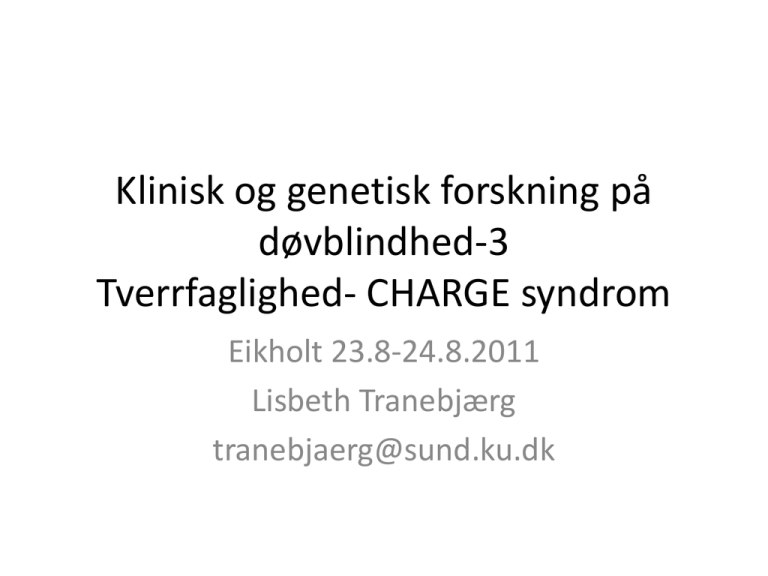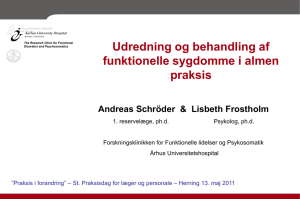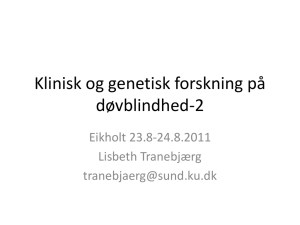Klinisk og genetisk forskning på døvblindhed-3
advertisement

Klinisk og genetisk forskning på døvblindhed-3 Tverrfaglighed- CHARGE syndrom Eikholt 23.8-24.8.2011 Lisbeth Tranebjærg tranebjaerg@sund.ku.dk Døvhetssyndromer:CHARGE, dynamik rundt diagnose, nye metoder.Tverrfaglige tiltak Lisbeth Tranebjærg tranebjaerg@sund.ku.dk Implications of a diagnosis Diagnosis-prognosis-treatment-counselling • Distinguish between genetic/non-genetic cause (CRS vs CHARGE, chromosomal abnormality) • Be tuned for early assessment of associated medical problems (WFS1 related disease/Usher syndrome/Alström) • Be prepared for progressive/stable condition, and guide choice of treatment (CI or not) and method of communication (CHARGE/Usher) • The parents always will ask: WHY OUR CHILD?? Rubella • Congenit rubella syndrom har likhetstrekk med CHARGE syndrom Congenital Rubella syndrome (CRS) • Created the awareness towards congenital deafblindness in general • Has almost disappeared as etiology • Miscarriage, hearing impairment, cataract, heart malformations, mental delay • Late -manifestations: diabetes mellitus, hypertension, neurological and psycho-social problems, endocrine abnormalities, early menopause, osteoporosis, progressive rubella panencephalitis(learning disability, ataxia, cerebral palsy, psychosis) CRS-Dammeyer, 2010 Dammeyer J Int J Pediatr Otorhinol 2010 ;74:1067-1070 Late manifestations of congenital rubella syndrome (CRS) ? Are they real? • 123 congenital deafblind adult individuals (evaluated in 2003) • N= 35 with CRS – average age 41 years • No evidence for more frequent occurrence of the postulated late-manifeatations cp with a group of 82 non-CRS cong deafblind individuals (etiology other or unknown) (Dammeyer J et al, 2010) Rubella? CHARGE? • Kvinne LC født 141258: • Syg Tvillinge søster GC141258 døde 1993 • LC født af 18 år gl kvinne, serologisk bekræftet rubella tidligt i svangerskabet. Afslag på ab. Prov. (!!!) • Jente tvillinger født med alvorlige misdannelser • CHD7-sekventering og and MLPA analyse af CDH7 var normale. • Konklusion: Congenital Rubella Syndrome. Tværfaglig udredning af syns-og høretab Multidisciplinarity in hereditary hearing impairment-examining the patient Genetic counselling GJB2 and other genes Family history Clinical photos Hearing impairment CT scan, Eye exam, Renal US Array CGH Geography and ethnicity Audiological Bioinformatics profile C-H-A-R-G-E Association (1979) • • • • • • C: Coloboma H: Heart malformation A: Atresia Choanae R: Retarded growth and development G: Genital-urinvejsabnormiteter E: Ear anomaly and/or hearing impairment (Pagon et al, 1981) This list no longer is recommended for diagnosis Epidemiologi Autosomal dominant syndrom- de fleste tilfælde er sporadiske Prævalens: Skøn: 1: 10.000- 1: 15.000 Canada: 1: ~ 8.500 levendefødte (UK: 250 pts) Ca 8 nye børn pr år i DK (?) Næsthyppigste årsag hos børn med døvblindhed 20% ud af 67 børn (Dammeyer J, Int J Audiol, 2010;49: 76-82) CHARGE:fra klinisk beskrivelse til så meget mere • 1979/81: Hall/Pagon- Diagnostiske kriterier • 2004: en spec pt: med chrom 8abn: CHD7 • 2005-2006: > 200 pts mutationsanalyseret • De sjældnere dukker op: familiære tilfælde, Kallman’s syndrom (oftest++), påvisning af de-novo mutation, sandsynliggøring af køns celle mosaik • • • • % af pts med påvist CHD7 mutation først meget høj (65-70%). Raten falder når flere klinisk variable pts us. Flere gener (type 1- type 2 etc)? Hvor mange? Næsthyppigste ætiologi hos danske døvblinde børn (20/67) (Dammeyer J, Int J Audiol, 2010;49: 76-82) Clinical criteria for CHARGE syndrome Major criteria 1. Coloboma, microphthalmia 2. Choanal atresia or stenosis† 3. Characteristic external ear anomaly, middle/inner ear malformations, mixed deafness Blake* (1998) 4. Cranial nerve dysfunction Minor criteria 1. Cardiovascular malformations 2. Tracheooesophageal defects 3. Genital hypoplasia or delayed pubertal development 4. Cleft lip and/or palate 5. Developmental delay 6. Growth retardation 7. Characteristic face Inclusion rule Typical CHARGE: 4 major or 3 major + 3 minor Clinical criteria for CHARGE syndrome Major criteria Verloes (2005) 1. Ocular coloboma 2. Choanal atresia 3. Hypoplastic semicircular canals Minor criteria 1. Heart or oesophagus malformation 2. Malformation of the middle or external ear 3. Rhombencephalic dysfunction including sensorineural deafness 4. Hypothalamohypophyseal dysfunction (gonadotropin or growth hormone deficiency) 5. Mental retardation Inclusion rule Typical CHARGE: 3 major or 2 major+2 minor Partial CHARGE: 2 major + 1 minor Atypical CHARGE: 2 major +0 minor or 1 major + 3 minor Overview of features occurring in CHARGE syndrome (frequencies are shown in table 2). Bergman J E H et al. J Med Genet 2011;48:334-342 ©2011 by BMJ Publishing Group Ltd Patient with typical CHARGE syndrome and a 22q11 deletion. Bergman J E H et al. J Med Genet 2011;48:334-342 ©2011 by BMJ Publishing Group Ltd Kliniske karakteristika Meta-analysis from 25 reports:254 pts with CDH7 mutations, and 125 were negative → Zentner GE et al. Molecular and phenotypic aspects of CHD7 mutation in CHARGE syndrome. Am J Med Genet 2010; 152A: 674-686 Klinik- hollandske erfaringer Feature CHD7 mut.(n=280) CHARGE før CHD7gen (n=124) Ext ear anomaly 97% 96% Cranial nerve dysf. 99% 86% Semicircular canal abn 94% 100% coloboma 81% 77% Choanal atresia 55% 61% Cleft lip/palate 48% 18% Feeding difficulties 82% 85% Facial palsy 66% 36% Inability to smell (anosmia) 80% Genital hypoplasia 81% 36% Klinik-hollandske erfaringer-cont’d Feature (cont’d) CHD7 mut (n=280) (Cont’d) CHARGE before CHD7 (n=124) Heart defect 76% 85% Tracheo-oesophageal anomaly 29% 18% Developmental delay Delayed motor milestones:98% Cognitive delay:74% Developmental delay:100% Growth retardation 37% 65% Typer af mutationer Mekanisme sandsynligvis haploinsufficiens da punkt mutationer og total deletion af CHD7 giver samme kliniske billede. Zentner GE et al. Molecular and phenotypic aspects of CHD7 mutation in CHARGE syndrome. Am J Med Genet 2010; 152A: 674-686 Guideline for CHD7 analysis in patients suspected of CHARGE syndrome. Bergman J E H et al. J Med Genet 2011;48:334-342 ©2011 by BMJ Publishing Group Ltd Atypiske CHARGE pts CHARGE-familial case-Fam A Diagnostic criteria: Major:1/3 1/3 2/3 Minor:2/5 5/5 3/5 Delahaye A et al. Clin Genet 2007; 72: 112-121 CHARGE-Familiær Fam A: • III:2: læbe-ganespalte, øsophagus atresi+ fistel, complex hjertefeil, og ribbensanomalier, lærevansker, ingen anosmi, kortvokst • III:3: retina colobom, ingen hjertefeil, gik 21 mdr gl, • II:2: asymptomatisk vestibulær abnormiteter, retina colobomdiagnosticeret efter børnenes diagnose, balanceproblemer som barn, normal mentalt. (Mosaik i kønsceller for mutationen?) • • CHD7 mutation: c.2501C>T; p.S834F (Delahaye A et al, 2007) Familial Kallmann syndrom with CHD7 mutation Mother healthy; no CHD7 mutation • I:1 I:2 DNA II:1 signe winther 070549CHD7-sekn exon 31:N/N DNA B8134-08 III:1 lene margrethe lohre 061072CHD7:exon 31 B7093-07 II:2 II:3 II:4 II:5 lohre DNA III:2 ann-elisabeth lohre 150578CHD7:exon 31 B7099-07 III:3 CHD7 mutation:exon 31: c.6221T>C; p.L2074P Neuropsychology: Deficient continous attention, memory,in particular visual, and reduced cognitive flexibility. Functions badly in work life,extremely easily distracted and works slowly III:4 19-y-old woman. Affected sister Anacusis dxt, anosmia, coloboma n. Opt. dxt, ptosis sin, very delayed growth and puberty, lack of growth hormone. H:164 cm, Bilat vesico-uret reflux, Pregnant x2→ Spont ab. • Father: anacusis sin, dupl ureter sin, died of AMI 40-y-old, coarctatio aortae. H:179 cm- not available for genetic test. • Sister:anacusis sin, anosmia, no coloboma,bilat vesico-uret reflux, delayed puberty,no deficiency of growth hormone. H:165 cm • MRI: missing the olfactory sulcus Levy CM & Knudtzon J.Clin Genet 1993; 43:51-53 Kallmann syndrome: lack of spontaneous puberty+ anosmia- many causes CHARGE syndrome- old pt • 56-year old cong.deaf-blind female- protected living conditions• An older brother died perinatally with similar malformations • Clinically: HA from age 17 years: conductive/sensorineural HI,right ear deaf • Eyes: left blind, glasses from age 42 years, incipient cataract,scars in retina, no colobomas • Never mentruated,hyperthyroidism,adipose • Broadbased gait, poor balance • Heart malformation • Unilateral facial paresis • Emotionally fragile • Peculiar behaviour • CHD7-sequencing: c.7252C>T: p.R2418X/N • CT scan of temporal bones: Mondini dysplasia, complete agenesis of semicircular canals,small orbital coloboma Atypical CHARGE- late diagnosis • MH 090801, 1. child- born to Turkish consanguineous parents • In 2002: severe HI diagnosed- sign language • Agenesis of acoustic nerve unilaterally, bilat agenesis of semicircular canals • CI operation had to be refused • No coloboma, or choanal atresia • Major problems with coordination of vision due to paresis of the abducens nerve • Hardly any feeding problems, good olfactory sense • Short stature (6,5 år gl: 103 cm) • Aud afd, neuropaediatrician, dept for growth and reproduction,eye dept: none raised the CHARGE suspicion • CHARGE diagnosis obtained by deafblind coordinator and geneticist in 2007 CHARGE adfærd fænotype (udkast-T.Hartshorne) • Lav normal cognitiv funktion • Meget målrettet, persisterende, og humoristisk sans • Socialt interesseret, men umoden • Repetitiv adfærd, øges under stress • Søger meget intenst sansestimuli • Under stress og sanseoverstimulation: svært at udøve selvregulerinmg og mister let konntrollen • Svært at skifte opmærksomhed og overgå til nye aktiviteter; bliver let fraværende i egne tanker Naturhistorien for CHARGE • Mange patienter og mutationer beskrevet: man kan begynde at ane et billede for en del af symptomerne: ex.vækst/pubertet, hjertemisdannelser, adfærd Pubertet/vækst Pubertet/vækst: ”the R and the G” • Forskellige faser med forskelligt normal biologisk mønster i spædbarn-barndom og ved pubertet • Jeremy Kirk’s opsummering fra SENSE kan anbefales • Anbefaling: opfølgning af en pædiatrisk endokrinolog Pubertet Lugtesans/pubertet • • • • Study on smell and puberty in CHARGE syndrome Smell deficiency and delayed or absent puberty often occur in CHARGE syndrome, but few studies have looked if these features are associated in adolescents with CHARGE syndrome. Therefore, we studied smell and pubertal development in 35 individuals with CHARGE syndrome from the Netherlands. In this study, we included 19 boys and 16 girls aged 10 years or older who all had a mutation in the CHD7-gene. We performed a smell test (the University of Pennsylvania Smell Identification Test, see the picture below) in all persons without mental retardation, bilateral choanal atresia and/or severe feeding difficulties (26/35). Also, we re-analyzed MRI brain scans (whenever available) for abnormalities of the olfactory bulbs (the area in the brain involved in olfaction). Pubertal development was evaluated by a paediatric endocrinologist who did a physical exam and measured hormone levels in blood. Pubertet/lugtesans • How often does a smell deficit occur in CHARGE syndrome? • Smell testing showed absent sense of smell in 21/26 (81%) individuals and normal or slightly decreased sense of smell in 5/26 (19%) individuals. History taking was not reliable for determining sense of smell. • MRI brain scans were available in 10 persons, but could be analysed for olfactory bulb abnormalities in only three persons. These three persons all had abnormal olfactory bulbs. • How often do individuals with CHARGE syndrome have delayed or absent puberty? • 23 Individuals were old enough to distinguish between delayed or normal puberty. In 17 persons puberty was delayed or absent (74%), whereas 6 persons had experienced normal puberty (26%). Pubertet/lugtesans • • • • • • • • • Was there a correlation between sense of smell and pubertal development? From 15 individuals complete data on both smell and puberty were available: 11 persons had both a smell deficit and delayed puberty and 4 persons had normal sense of smell in combination with normal pubertal development. Seven boys were too young to know if they would enter puberty at a normal age, but they all had cryptorchidism or a micropenis, which is suggestive for delayed puberty. These seven boys had no sense of smell. Therefore, a total of 22 persons showed concordance between smell and (suspected) pubertal development. We conclude that smell and pubertal development are 100% correlated in this study. • • • • • • • • Can a smell test predict whether spontaneous puberty will occur? Because of the correlation between sense of smell and pubertal development, a smell test can probably predict whether spontaneous puberty will occur. When a patient with CHARGE syndrome is unable to smell, he/she will probably need hormone replacement therapy to enter puberty. We recommend timely start of hormone replacement therapy in children with CHARGE syndrome who have no sense of smell to make sure they enter puberty simultaneously with their peers. This will reduce social problems and risk of osteoporosis (brittle bone disease). Fraværende lugtesans som prædiktor af udebleven spontan pubertet? • 35 personer m. CHD7 mutation • Komplette data på 15 pts:11 havde komplet anosmi og HH • 4 hypo/normo osmi + spontan pubertet • Konklusion:Opstart af hormonel induktion af pubertet på aldersadækvat tidspunkt Bergman JEH et al; J Pediatrics 2011;158:474-479 Klinisk 0pfølgning-del1 Evaluation Ophthalmology Tests Treatment/advice Be aware of Full ophthalmological examination including funduscopy Tinted spectacles for photophobia (iris coloboma) Artificial tears in case of facial palsy Retinal detachment (in case of retinal coloboma) Correction of refraction errors Klinisk 0pfølgning-del2-ENT-part 1 Evaluation ENT, audiology, occupational/speech therapy, gastroenterology Tests Multidisciplinary evaluation: Assess patency of choanae (CT scan or nasal endoscopy) Evaluation for cleft palate and tracheooesophageal anomalies Audiometry (BAER), tympanometry Temporal bone CT scan (pathology of middle ear, inner ear, cranial nerves, semicircular canals, aberrant course of blood vessels or cranial nerves) Treatment/advice Surgical correction of choanal atresia Hearing aids, ventilation tubes Sign language and speech training GORD: Nissen fundoplication, antispasmodics Be aware of Respiratory aspiration (recurrent pneumonias) Aberrant course of blood vessels or cranial nerves when surgery for cochlear implants Klinisk 0pfølgning-del3-ENT-part 2 Evaluation ENT, audiology, occupational/speec h therapy, gastroenterology Tests Cranial nerve function tests Swallowing studies, pH monitoring, reflux scan in case of feeding/swallowing difficulties University of Pennsylvania Smell Identification Test Treatment/advice Be aware of Gastrostomy/trache Obstructive sleep otomy in case of apnoea severe swallowing problems Surgery of tracheooesophageal abnormalities Advice concerning anosmia Klinisk 0pfølgning-del 4 Evaluation Paediatrics/endocri nology Tests Treatment/advice Renal ultrasound, voiding cystourethrogram in case of urinary infections Immunological studies in case of recurrent infections or suspected hypocalcaemia Follow-up of growth and development (growth hormone stimulation test if indicated) Monitor cryptorchidism Gonadotropin levels (age 6–8 Be aware of Early treatment of bladder infections (especially in case of unilateral renal agenesis or vesicourethral reflux) Growth hormone treatment if growth hormone deficiency is present Orchidopexy when indicated Gonadotropin treatment in case of hypogonadotropic Klinisk 0pfølgning-del 5 Evaluation Cardiology Anaesthesiology Tests Cardiac evaluation including ultrasound Extensive preoperative assessment Treatment/advice Be aware of Cardiac surgery and/or antibiotic prophylaxis Combine surgical procedures whenever possible Longer surveillance after surgery Postoperative complications (due to aspiration/cranial nerve dysfunction) Problems with intubation Klinisk 0pfølgning-del 6 Evaluation Neurology Tests Treatment/advice Be aware of Cerebral MRI scan (including visualisation of olfactory bulbs, and inner ear if no Anticonvulsants if temporal bone CT overt epilepsy seen scan has been performed) EEG (only when clinically seizures are observed) Klinisk 0pfølgning-del 7 Evaluation Behaviour, developmental and educational services Tests Extensive multidisciplinary evaluation of developmental and sensory impairments and behavioural problems Use formal tests in order to screen for autism spectrum, obsessive compulsive disorders and ADHD Perform IQ tests regularly Treatment/advice Integrated individualised therapy with special attention for optimising communication Be aware of Klinisk 0pfølgning-del 8 Evaluation Tests Treatment/advice Be aware of Physiotherapy Assessment of balance problems, motor delay, visiospatial coordination, and hypotonia Therapy for hypotonia and devices to overcome balance impairment Genetics CHD7 analysis (when no CHD7 mutation or deletion is found, perform array CGH) Genetic Intra-familial counselling, options variability in for prenatal CHARGE syndrome diagnosis Differentialdiagnoser til CHARGE • Hvad så?? CHARGE?? • KR 211298: • Bilat Choanal atresi, ve.sid iris colobom, VSD + DAP, corpus callosum agenesi,ADHD, Tourette lign verbale udsagn, agenesi af permente tænder, dysmorf, kranienervedysfunktion? (smil), ikke CT scannet for semicirkulære kanaler, ingen HN, ingen genital hypoplasi. • CHD7-sekv: N, MLPA:N , • Kromosomanalyse: normal, array CGH Normal KR 211298 CHARGE?- mutation i ukendt gen? Kromosomsyndrom? Nyttige informationskilder • http://www.servicestyrelsen.dk/dovblindfodt • Artikler, indtryk fra SENSe konferencen marts 2011 mm • Præsentationer fra CHARGE samlingen 11.3-13.3 2011 i UK: www.sense.org.uk • http://www.chargesyndrome.org.uk • Præsentationer fra CHARGE konf, UK marts 2011 • • • • Resources for families An overview of CHARGE syndrome (pdf 91kb) CHARGE for Beginners (pdf 94kb) Coming of Age (pdf 77kb) Hormones in CHARGE syndrome (pdf 74kb) Moments of togetherness (pdf 336kb) Parenting children with CHARGE (pdf 144kb) Puberty and smell in CHARGE syndrome (pdf 50kb) Sensory processing (pdf 574kb) Sources of challenging behaviour (pdf 218kb) Successful teaching strategies (pdf 183kb) The challenge of mealtimes (pdf 547kb) The genetics of CHARGE (pdf 133kb) The heart in CHARGE (pdf 279kb) Resources for professionals Hormones in CHARGE syndrome (pdf 74kb) The genetics of CHARGE (pdf 26kb) The impact of relationships (pdf 1060kb) An overview of CHARGE syndrome (pdf 91kb) Sources of challenging behaviour (pdf 177kb) Successful teching strategies (pdf 183kb) The challenges of mealtimes (pdf 549kb)

